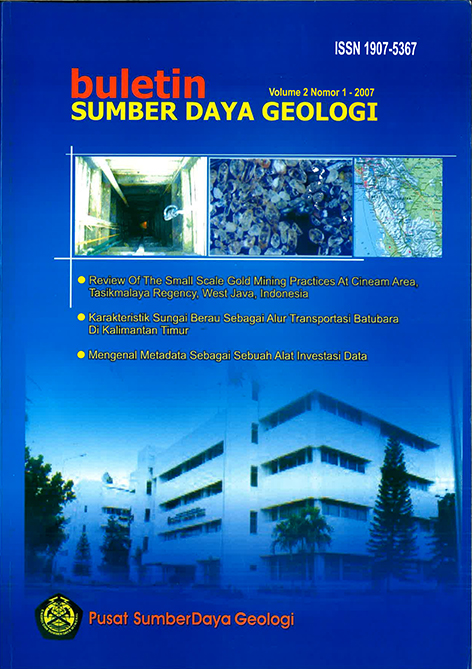CIRI KHAS STRUKTUR TAHANAN JENIS DI DAERAH PANAS BUMI TEMPERATUR TINGGI: STUDI KASUS DAERAH PANAS BUMI JABOI-PULAU WEH
Abstract
Anomali tahanan jenis rendah yang teramati pada sistem panas bumi di lingkungan vulkanik sangat penting untuk menentukan target-target eksplorasi. Anomali-anomali tahanan jenis secara umum memperlihatkan anomali rendah di suatu zona di atas resevoir panas bumi. Suatu model khas tentang struktur tahanan jenis dari daerah panas bumi di lingkungan vulkanik telah dikaji oleh beberapa ahli geofisika untuk mengerti faktor-faktor yang mernpengaruhi tahanan jenis di daerah panas bumi, dimana memperlihatkan bahwa produk-produk lempung konduktif dari hasil alterasi hidrotermal adalah yang paling umum sebagai penyebab keberadaan tahanan jenis rendah di atas reservoir.
Penyelidikan tahanan jenis listrik de Schlumberger telah dilakukan di daerah panas bumi Jaboi, Pulau Weh, Nangroe Aceh Darussalam pada tahun 2005. Hasilnya memperlihatkan suatu delineasi zona tahanan jenis rendah yang berkaitan dengan zona prospek panas bumi Jaboi. Pola sebaran lateral tahanan jenis memperlihatkan zona-zona outflow ke arah mata air panas Jaboi dan Keuneukai. Struktur tahanan jenis memperlihatkan suatu lapisan konduktif kaya mineral lempung berbentuk cendawan dimana puncaknya rnendekat ke permukaan di bawah daerah fumarola Jaboi dan ke sisi-sisinya sernakin mendalam, dengan ketebalan yang bervariasi antara 200 m di daerah furnarola sampai 1100 m jauh di luar fumarola, Hasil perbandingan memperlihatkan bahwa delineasi zona rendah dan kecenderungan bentuk anomali tahanan jenis daerah Jaboi ini rnempunyai kemiripan dengan tipikal struktur tahanan jenis di daerah vulkanik bertempatur tinggi.
Downloads
References
nderson E., Crosby D., and Ussher G (2000). Bull-eye Simple resistivity imaging to reliably loCate the geothermal reservoir.
ProCeeding World Geothernwl Congress 2000.
anwell, C. J. and Macdonald, W.J.P, 1965. Resistivity surveying in New Zealand thennal areas. Commonwealth Mining and
Metallurgical Congress, Australia and ?ew Zealand, New Zealand Section pp I- 7.
Jhnston, J.M., Pellerin, L. and Hohmann, G. W. ( 1992). Evaluation of electromagnetic methods for geothermal reservoir detection. Geothermal Resources Council Transaction, Vol. 16 pp 241-245.
:isk. 1986. Reconnaissance and follow-up resistivity surveying of New Zealand geothermal fields. ProC. 8th New Zealand Geothermal Workshop 1986, pp 7 5-80.
;uhanto, E. and Soemantri, M., 2003. Geophysical study of Mangolo geothermal field, Kolaka Southeast Sulawesi. ProC. 6th Annual Convercnce of INAGA.2003.
Jssher G .. Harvey C., Johnstone R., and And~rson E. (2000). Understanding the resistivities observed in geotheru1al systeJll5 PrnCeeding World Geothermal Congress 2000.
Copyright (c) 2018 Buletin Sumber Daya Geologi

This work is licensed under a Creative Commons Attribution-NonCommercial-ShareAlike 4.0 International License.
Authors whose manuscripts are published agree to the following terms:
The publication rights of all journal manuscript materials published on the Buletin Sumber Daya Geologi website are held by the editorial board with the knowledge of the author (moral rights remain with the manuscript’s author).
The formal legal provisions for access to digital articles in this electronic journal are subject to the terms of the Creative Commons Attribution-ShareAlike (CC BY-SA) license. This means that Buletin Sumber Daya Geologi has the right to store, convert media/formats, manage in the form of a database, maintain, and publish the article without requesting permission from the author, as long as the author’s name is cited as the copyright holder.
Manuscripts published in both print and electronic formats are open access for educational, research, investigative, and library purposes. Beyond these purposes, the editorial board is not responsible for any violations of copyright law.















